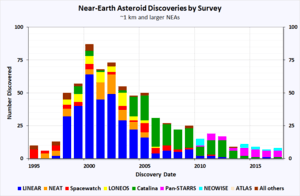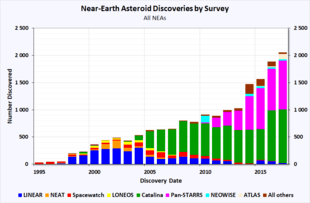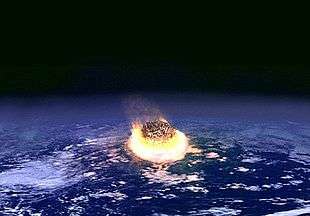Asteroid Terrestrial-impact Last Alert System
| Survey type |
Astronomical survey |
|---|---|
| Target |
Near-Earth object |
| Observatory code |
T05 (ATLAS-HKO) T08 (ATLAS-MLO) |
| Website |
fallingstar |
The Asteroid Terrestrial-impact Last Alert System (ATLAS; Observatory codes T05 and T08) is a robotic astronomical survey and early-warning system for detecting smaller near-Earth objects a few weeks to days before they impact Earth. Funded by NASA, and developed and operated by the University of Hawaii's Institute for Astronomy, the system's current two 0.5-meter telescopes are located at Haleakala (ATLAS-HKO) and Mauna Loa (ATLAS-MLO) observatories, on two of the Hawaiian Islands and 160 km apart. Each of the two telescope surveys one quarter of the whole observable sky four times per clear night, for a four-fold coverage of the observable sky every two clear nights.[1] ATLAS began observations in 2015. Its two-telescope version is fully operational since 2017, and the project has obtained NASA funding for two additional telescopes in the Southern hemisphere.
Context
Major astronomical impact events have significantly shaped Earth's history, having been implicated in the formation of the Earth–Moon system, the evolutionary history of life, the origin of water on Earth and several mass extinctions. Notable prehistorical impact events include the Chicxulub impact, 66 million years ago, believed to be the cause of the Cretaceous–Paleogene extinction event.[2] The 37 million years old asteroid impact that caused Mistastin crater generated temperatures exceeding 2,370 °C, the highest known to have occurred on the surface of the Earth.[3]
Throughout recorded history, hundreds of Earth impacts (and exploding bolides) have been reported, with some rarer occurrences causing deaths, injuries, property damage, or other significant localised consequences.[4] One of the best-known recorded events in modern times was the 1908 Tunguska event, which occurred over a very sparsely populated part of Siberia, Russia. The 2013 Chelyabinsk meteor event is the only known such incident in historical times to result in a large number of injuries, with the possible exception of the poorly documented 1490 Ch'ing-yang event in China. The approximately 20 meter Chelyabinsk meteor is the largest recorded object to have encountered a continent of the Earth since the Tunguska event.
In April 2018, the B612 Foundation reported "It's a 100 per cent certainty we'll be hit [by a devastating asteroid], but we're not 100 per cent sure when."[5][6] In June 2018, the US National Science and Technology Council warned that America is unprepared for an asteroid impact event, and has developed and released the "National Near-Earth Object Preparedness Strategy Action Plan" to better prepare.[7][8][9][10][11]
Overview

- LINEAR
- NEAT
- Spacewatch
- LONEOS
- CSS
- Pan-STARRS
- NEOWISE
- Others
The ATLAS project was developed at the University of Hawaii with US$5 million funding from NASA,[12] and its first element was deployed in 2015. The first telescope became fully operational at the end of 2015, and the second one in March 2017. Replacement of the initially substandard Schmidt corrector plates of both telescopes in June 2017 brought their image quality to its nominal 2 pixels (3.8") width and improved their sensitivity by one magnitude.[13] In August 2018, the project obtained NASA funding to install two telescopes in the Southern hemisphere, one of which will be hosted by the South African Astronomical Observatory.[14][15] This geographical expansion of ATLAS will provide visibility of the far Southern sky, more continuous coverage, better resilience to bad weather, and additional information on the orbit from the parallax effect.[16] The full ATLAS concept consists of eight telescopes, spread over the globe for full-sky and 24h/24h coverage.
As long as their radiant is not too close to the Sun, and for the current Hawaii-based system not too far into the Southern hemisphere, the automated system provides a one-week warning for a 45 metres (150 ft) diameter asteroid, and a three-week warning for a 120 m (390 ft) one.[12] By comparison, the February 2013 Chelyabinsk meteor impact was from an object estimated at 17 m (60 ft) diameter. Its radiant happened to be very close to the Sun and it therefore was in the blind spot of any ATLAS-like system, but a similar object arriving from a dark direction would be detected by ATLAS a few days in advance.
As a by-product of its main design goal, ATLAS probes any moderately bright moving or variable object in the night sky. It therefore also looks for non-impacting asteroids, comets, dwarf planets, variable stars,[17] and supernovae.[12]
Naming
The Last Alert part of the system name refers to the fact that ATLAS will find smaller asteroids years too late for potential deflection, but would provide the days or weeks of warning needed to evacuate and otherwise prepare a target area. According to ATLAS project lead John Tonry, "that's enough time to evacuate the area of people, take measures to protect buildings and other infrastructure, and be alert to a tsunami danger generated by ocean impacts".[18] Much of the limited damage and injuries caused by the 17-m Chelyabinsk meteor impact were from window glass broken by its shock wave,[19] and with advance warning those losses could have been much reduced by actions as simple as propping all windows open before the impact and staying away from them.
Design and operation
The full ATLAS concept consists of eight 50-centimeter diameter f/2 Wright-Schmidt telescopes, spread over the globe for full-sky and 24h/24h coverage, and each fitted with a 110 Megapixel CCD array camera. The current system consists of two such telescopes operating on Haleakala and Mauna Loa in the Hawaiian Islands, ATLAS1 and ATLAS2.[20] A major feature of these telescopes is their large 7.4° field of view - about 15 times the diameter of the full moon. This system can image the whole night sky visible from Hawaii with about 1000 separate telescope pointings. At 30 seconds per exposure plus 5 seconds for readout, each ATLAS telescope can therefore scan the whole visible sky a little over once each night, with a median completeness limit at apparent magnitude 19. Since the mission of the telescope is to identify moving objects, each telescope actually observes one quarter of the sky four times in a night at approximately 15-minute intervals, as needed to link multiple observations of an asteroid into a preliminary orbit and predict its approximate position on subsequent nights. Apparent magnitude 19 is astronomer-speak for "respectably but not extremely faint", and it is the equivalent to the light of a match flame in New York viewed from San Francisco. ATLAS therefore scans the visible sky in much less depth, but much more quickly, than larger surveying telescope arrays such as University of Hawaii's Pan-STARRS. Pan-STARRS goes approximately 100 times deeper, but needs over two weeks to scan the whole sky just once.[12]
NASA's Near Earth Observation Program initially provided a US$5 million grant, with $3.5 million covering the first three years of design, construction and software development, and the balance of the grant to fund the systems operation for two years following its entry into full operational service in late 2015.[21] Further NASA grants fund continued operation of ATLAS until 2021[22] and the construction of two Southern telescopes.[14]
Discoveries
- AT2018cow, possibly Supernova 2018cow on 2018-06-16.
- 2018 AH, largest asteroid to pass so close to Earth since 1972 on 2018-06-02.
- A106fgF, unconfirmed potential impactor on 2018-01-22.
- 2018 RC, near earth asteroid on 2018-09-03 (notable because it was discovered more than a day prior to closest approach on 2018-09-09). [23]
See also
References
- ↑ Tonry; et al. (28 March 2018). "ATLAS: A High-Cadence All-Sky Survey System". Publications of the Astronomical Society of the Pacific. 130 (988): 064505. arXiv:1802.00879. Bibcode:2018PASP..130f4505T. doi:10.1088/1538-3873/aabadf. Accessed 2018-04-14.
- ↑ Becker, Luann (2002). "Repeated Blows" (PDF). Scientific American. 286 (3): 76–83. Bibcode:2002SciAm.286c..76B. doi:10.1038/scientificamerican0302-76. PMID 11857903. Retrieved 28 January 2016.
- ↑ Dvorsky, George (2017-09-17). "The Hottest Known Temperature On Earth Was Caused By An Ancient Asteroid Strike". Gizmodo. Retrieved 2017-09-17.
- ↑ Lewis, John S. (1996), Rain of Iron and Ice, Helix Books (Addison-Wesley), p. 236, ISBN 0-201-48950-3
- ↑ Harper, Paul (28 April 2018). "Earth will be hit by asteroid with 100% CERTAINTY – space experts warn - EXPERTS have warned it is "100pc certain" Earth will be devastated by an asteroid as millions are hurling towards the planet undetected". Daily Star. Retrieved 25 June 2018.
- ↑ Homer, Aaron (28 April 2018). "Earth Will Be Hit By An Asteroid With 100 Percent Certainty, Says Space-Watching Group B612 - The group of scientists and former astronauts is devoted to defending the planet from a space apocalypse". Inquisitr. Retrieved 25 June 2018.
- ↑ Staff (21 June 2018). "National Near-Earth Object Preparedness Strategy Action Plan" (PDF). White House. Retrieved 25 June 2018.
- ↑ Mandelbaum, Ryan F. (21 June 2018). "America Isn't Ready to Handle a Catastrophic Asteroid Impact, New Report Warns". Gizmodo. Retrieved 25 June 2018.
- ↑ Myhrvold, Nathan (22 May 2018). "An empirical examination of WISE/NEOWISE asteroid analysis and results". Icarus. 314: 64–97. Bibcode:2018Icar..314...64M. doi:10.1016/j.icarus.2018.05.004. Retrieved 25 June 2018.
- ↑ Chang, Kenneth (14 June 2018). "Asteroids and Adversaries: Challenging What NASA Knows About Space Rocks - Two years ago, NASA dismissed and mocked an amateur's criticisms of its asteroids database. Now Nathan Myhrvold is back, and his papers have passed peer review". The New York Times. Retrieved 25 June 2018.
- ↑ Chang, Kenneth (14 June 2018). "Asteroids and Adversaries: Challenging What NASA Knows About Space Rocks - Relevant Comments". The New York Times. Retrieved 25 June 2018.
- 1 2 3 4 University of Hawaii at Manoa's Institute for Astronomy (18 February 2013). "ATLAS: The Asteroid Terrestrial-impact Last Alert System". Astronomy Magazine. Retrieved 2013-02-22.
- ↑ Henry Weiland (18 February 2013). "New Schmidt Correctors Installed!". Retrieved 2017-10-12.
- 1 2 Project that spots city-killing asteroids expands to Southern Hemisphere.
- ↑ "SAAO to contribute to the global effort to detect Near Earth Objects."
- ↑ Atlas: How it works. Asteroid Terrestrial-impact Last Alert System.
- ↑ Heinze, A. N; Tonry, John L; Denneau, Larry; Flewelling, Heather; Stalder, Brian; Rest, Armin; Smith, Ken W; Smartt, Stephen J; Weiland, Henry (2018). "A First Catalog of Variable Stars Measured by the Asteroid Terrestrial-impact Last Alert System (ATLAS)". arXiv:1804.02132 [astro-ph.SR].
- ↑ Clark, Stuart (20 June 2017). "Asteroids and how to deflect them". The Guardian. Retrieved 2013-02-22.
- ↑ Heintz, Jim; Isachenkov, Vladimir (15 February 2013). "Meteor explodes over Russia's Ural Mountains; 1,100 injured as shock wave blasts out windows". Postmedia Network Inc. The Associated Press. Archived from the original on 13 May 2013.
Emergency Situations Ministry spokesman Vladimir Purgin said many of the injured were cut as they flocked to windows to see what caused the intense flash of light, which was momentarily brighter than the sun.
- ↑ ATLAS Telescope 2 Installed on Mauna Loa, Ari Heinze Retrieved April 7, 2017.
- ↑ Oliver, Chris. ATLAS Project Funded by NASA, Nā Kilo Hōkū (newsletter), Institute for Astronomy, University of Hawaii, No. 46, 2013, p. 1. Retrieved August 2, 2014.
- ↑ ATLAS Update #18: 2017 March Retrieved April 14, 2017.
- ↑ Minor Planet Center records for 2018 RC

